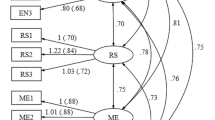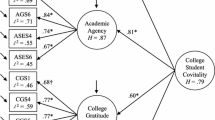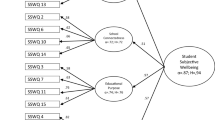Abstract
The present study investigated the predictive validity of two competing measurement models underlying the Student Subjective Wellbeing Questionnaire (SSWQ)—first-order and second-order—relative to several specific classes of adolescent problem behaviors: antisocial behavior, alcohol use, tobacco use, suicidal tendencies, nutrition habits, and school dropout. Analyses conducted with a sample or urban high-school students in Turkey (Grades 9–12, N = 374) demonstrated that the SSWQ’s first-order measurement model, which consisted of four fully-correlated factors (i.e., joy of learning, school connectedness, academic efficacy, and educational purpose), and second-order measurement model, which structured these four first-order factors as indicators of one second-order factor (i.e., student covitality), both indicated good data–model fit and strong internal reliability with the present sample. Additionally, results showed that both measurement models had substantive and relatively similar predictive power, characterized by moderate to large effect sizes, for accounting for the variance in all of the problem behaviors of interest. Findings regarding the predictive validity of the first-order measurement model further indicated that the predictive power of this model was primarily limited to two of the four students subjective wellbeing factors: academic efficacy and educational purpose. Implications for theory, practice, and future research are discussed.

Similar content being viewed by others
References
Degenhardt, L., Hall, W., & Lynskey, M. (2003). What is comorbidity and why does it occur? In M. Teesson & H. Proudfoot (Eds.), Comorbidity mental health disorders and substance use disorders: epidemiology, prevention and treatment (pp. 10–25). Sydney: National Drug and Alcohol Research Centre, University of New South Wales.
Diener, E., Oishi, S., & Lucas, R. E. (2009). Subjective well-being: the science of happiness and life satisfaction. In S. J. Lopez & C. R. Snyder (Eds.), Oxford handbook of positive psychology (2nd ed., pp. 187–194). New York: Oxford.
Dowdy, E., Furlong, M. J., Raines, T. C., Bovery, B., Kauffman, B., Denver, B. V., Price, M., & Murdock, J. (2015). Enhancing school-based mental health services with a preventive and promotive approach to universal screening for complete mental health. Journal of Educational and Psychological Consultation, 25, 1–20. doi:10.1080/10474412.2014.929951.
Furlong, M. J., You, S., Renshaw, T. L., O’Malley, M. D., & Rebelez, J. (2013). Preliminary development of the positive experiences at school scale for elementary school children. Child Indicators Research, 6, 753–775. doi:10.1007/s12187-013- 9193-7.
Furlong, M. J., You, S., Renshaw, T. L., Smith, D. C., & O’Malley, M. D. (2014a). Preliminary development and validation of the social and emotional health survey for secondary students. Social Indicators Research, 117, 1011–1032. doi:10.1007/ s11205-013-0373-0.
Furlong, M. J., Dowdy, E., Carnazzo, C., Bovery, B. L., & Kim, E. (2014b). Covitality: Fostering the building blocks of complete mental health. NASP Communiqué, 42(8), 1, 28–29.
Gençtanırım, D., & Ergene, T. (2014). Development of the Risk Behaviors Scale: Validity and reliability studies. International Journal of Social Science, 25, 125–138. doi:10.9761/JASSS2304
Gilman, R., & Huebner, S. (2003). A review of life satisfaction research with children and adolescents. School Psychology Quarterly, 18, 192–205. doi:10.1521/scpq.18.2.192.21858.
Hayes, S. C., Nelson, R. O., & Jarrett, R. B. (1987). The treatment utility of assessment: a functional approach to evaluating assessment quality. American Psychologist, 42, 963–974. doi:10.1037/0003-066X.42.11.963.
Huebner, E. S., Suldo, S. M., Smith, L. C., & McKnight, C. G. (2004). Life satisfaction in children and youth: empirical foundations and implications for school psychologists. Psychology in the Schools, 41, 81–93. doi:10.1002/pits.10140.
International Test Commission. (2005). International guidelines on test adaptation. Retrieved from https://www.intestcom.org/files/guideline_test_adaptation.pdf
Jones, C. N., You, S., & Furlong, M. J. (2013). A preliminary examination of covitality as integrated well-being in college students. Social Indicators Research, 111, 511–526. doi:10.1007/s11205-012-0017-9.
Kenny, D. A. (2014). Measuring model fit in structural equation modeling. Retrieved from www.davidakenny.net/cm/fit.htm.
Kim, E. K., Furlong, M. J., Dowdy, E., & Felix, E. D. (2014). Exploring the relative contributions of the strength and distress components of dual-factor complete mental health screening. Canadian Journal of School Psychology, 29, 127–140. doi:10.1177/0829573514529567.
Kline, R. B. (2008). Becoming a behavioral science researcher: a guide to producing research that matters. New York: Guilford.
Kline, R. B. (2010). Principles and practice of structural equation modeling (3rd ed.). New York: Guilford.
Renshaw, T. L. (2015). A replication of the technical adequacy of the student subjective wellbeing questionnaire. Journal of Psychoeducational Assessment, 33, 757–768. doi:10.1177/0734282915580885.
Renshaw, T. L. (2016a). Using so-called “mind–body practices” to promote youths’ wellbeing: Reflections on therapeutic outcomes, strategies, and processes. International Journal of School & Educational Psychology. doi:10.1080/21683603.2016.1130587 .Advance online publication
Renshaw, T. L. (2016b). Technical adequacy of the Positive Experiences at School Scale with adolescents. Journal of Psychoeducational Assessment. doi:10.1177/0734282915627920 .Advance online publication
Renshaw, T. L., & Arslan, G. (2016). Psychometric properties of the Student Subjective Wellbeing Questionnaire with Turkish adolescents: A generalizability study. Canadian Journal of School Psychology. doi:10.1177/0829573516634644 .Advance online publication
Renshaw, T. L., & Bolognino, S. J. (2016). The college student subjective wellbeing questionnaire: a brief, multidimensional, domain-specific measure of undergraduates’ covitality. Journal of Happiness Studies, 17, 463–484. doi:10.1007/s10902-014-9606-4.
Renshaw, T. L., Furlong, M. J., Dowdy, E., Rebelez, J., Smith, D. C., O’Malley, M. D., Lee, S., & Frugård Strøm, I. (2014). Covitality: a synergistic conception of adolescents’ mental health. In M. J. Furlong, R. Gilman, & E. S. Huebner (Eds.), Handbook of positive psychology in the schools (2nd ed., pp. 12–32). New York: Routledge.
Renshaw, T. L., Long, A. C. J., & Cook, C. R. (2015). Assessing adolescents’ positive psychological functioning at school: development and validation of the student subjective wellbeing questionnaire. School Psychology Quarterly, 30, 534–552. doi:10.1037/spq0000088.
Scales, P. C. (1999). Reducing risks and building developmental assets: essential actions for promoting adolescent health. Journal of School Health, 69, 113–119. doi:10.1111/j.1746-1561.1999.tb07219.x.
Scales, P. C., Benson, P. L., Roehlkepartain, E. C., Semsa, A., & Van Dulmen, M. (2006). The role of developmental assets in predicting academic achievement: a longitudinal study. Journal of Adolescence, 29, 691–708. doi:10.1016/j.adolescence.2005.09.001.
Seligman, M. E. P. (2011). Flourish: a visionary new understanding of happiness and well-being. New York: Free Press.
Suldo, S. M., & Shaffer, E. J. (2008). Looking beyond psychopathology: the dual-factor model of mental health in youth. School Psychology Review, 37, 52–68.
You, S., Furlong, M. J., Dowdy, E., Renshaw, T. L., Smith, D. C., & O’Malley, M. D. (2014). Further validation of the social and emotional health survey for high school students. Applied Research in Quality of Life, 9, 997–1105. doi:10.1007/s11482-013-9282-2.
You, S., Furlong, M. J., Felix, E., & O’Malley, M. (2015). Validation of the social and emotional health survey for five sociocultural groups: Multigroup invariance and latent mean analyses. Psychology in the Schools, 52, 349–362. doi:10.1002/pits.21828.
Author information
Authors and Affiliations
Corresponding author
Ethics declarations
Conflict of Interest
The authors declare no conflict of interest.
Experiment Participants
The experimental protocol was approved by the authors’ institutional review board and meets all requirements laid out by governing agencies for ethical research.
Funding
No funding was received to support the present research.
Ethical Approval
All procedures involving human participants in this study were conducted in accordance with the ethical standards of the authors’ institutional research committees and with the 1964 Helsinki declaration and its later amendments or comparable ethical standards.
Informed Consent
Informed consent was obtained from all individual participants included in the study.
Rights and permissions
About this article
Cite this article
Arslan, G., Renshaw, T.L. Student Subjective Wellbeing as a Predictor of Adolescent Problem Behaviors: a Comparison of First-Order and Second-Order Factor Effects. Child Ind Res 11, 507–521 (2018). https://doi.org/10.1007/s12187-017-9444-0
Accepted:
Published:
Issue Date:
DOI: https://doi.org/10.1007/s12187-017-9444-0




